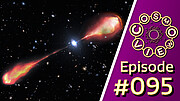Astronomers have discovered a remarkably clumpy rotating galaxy that existed just 900 million years after the Big Bang, shedding new light on how galaxies grew and evolved in the early universe. Nicknamed the “Cosmic Grapes,” the galaxy appears to be composed of at least 15 massive star-forming clumps—far more than current theoretical models predict could exist within a single rotating disk at this early time.
The discovery was made possible by an extraordinary combination of observations from the Atacama Large Millimeter/submillimeter Array (ALMA) and the James Webb Space Telescope (JWST), all focused on a single galaxy that happened to be perfectly magnified by a foreground galaxy cluster through gravitational lensing. In total, more than 100 hours of telescope time were dedicated to this single system, making it one of the most intensively studied galaxies from the early universe.
Although the galaxy had appeared as a smooth, single disk-like object in previous Hubble images, the powerful resolution of ALMA and JWST, enhanced by gravitational lensing, revealed a dramatically different picture: a rotating galaxy teeming with massive clumps, resembling a cluster of grapes. The finding marks the first time astronomers have linked small-scale internal structures and large-scale rotation in a typical galaxy at cosmic dawn, reaching spatial resolutions down to just 10 parsecs (about 30 light-years).
This galaxy does not represent a rare or extreme system. It lies squarely on the “main sequence” of galaxies in terms of its star forming activity, mass, size, chemical composition—meaning it is likely representative of a broader population. If so, many other seemingly smooth galaxies seen by current facilities may actually be made up of similar unseen substructures, hidden by the limits of current resolution.
Because existing simulations fail to reproduce such a large number of clumps in rotating galaxies at early times, this discovery raises key questions about how galaxies form and evolve. It suggests that our understanding of feedback processes and structure formation in young galaxies may need significant revision. The Cosmic Grapes now offer a unique window into the birth and growth of galaxies — and may be just the first of many. Future observations will be key to revealing whether such clumpy structures were common in the universe’s youth.
About NRAO
About ALMA
ALMA construction and operations are led by ESO on behalf of its Member States; by the National Radio Astronomy Observatory (NRAO), managed by Associated Universities, Inc. (AUI), on behalf of North America; and by the National Astronomical Observatory of Japan (NAOJ) on behalf of East Asia. The Joint ALMA Observatory (JAO) provides the unified leadership and management of the construction, commissioning and operation of ALMA.





















